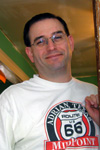
North American Total Solar Eclipse
US Highway 20 Rest Stop, 50 Miles West of Casper, WY, USA
August 21, 2017, 1742 UTC (11:42AM-Local)
© 2017 David Schaubert, All Rights Reserved.
We based out of Ogden, UT, to have a choice of locations in Oregon, Idaho, or Wyoming depending on the best last-minute weather forecast (Interstate Highways towards each from there). Turned out all three were pretty much equivalent for cloud conditions so we chose Wyoming as the people forecast (how many traveling to see the eclipse) was 80K, vs 500-750K+ for Oregon. Turned out as a good choice as there was only some low clouds to the West and a slight haze from prairie grass fires.
I'd been through the area before doing Amateur Radio so I knew the spot. We could have set up at a little more isolated location (less people) exactly on the eclipse centerline but opted for the availability of flush toilets (always a consideration when operating in remote areas) and it only put us a mile or so North of the centerline. The rest stop was a popular choice and even had two tour buses show up that brought in a large group of telescope wielding observers.
In addition to taking a panorama during totality I ran two video cameras and two still cameras (yes, it was a busy time). I zeroed the panorama camera at the azimuth at totality and started a timer before first contact that took an exposure every minute. I had built a solar filter attachment that fit over the fisheye lens. I also built filter for my still camera with an 18-270mm Superzoom set at 270mm. I manually took exposures every minute starting at first contact. As I didn't have a clock drive I also had to adjust the tripod every five minutes or so to keep the sun centered in the frame.
At the start of totality, I removed the filter from the pano lens and took six exposures around for the pano and reset the camera, filter, and timer to continue until last contact. I then ran over to my still camera, removed the filter, and took exposures of the totality while varying the shutter speed from overexposed to underexposed to get exposures of the sun's full corona. At the end of totality I took a few exposures of the 'ring' (the totality ring with the sun peeking out on one side) and replaced the filter.
After totality ended, I continued to take exposures every minute until Last Contact 80 minutes later.
Alas, my assistants who were supposed to take some exposures during totality with my 1000mm mirror lens were so overwhelmed by the event they forgot about it <sigh>
The two video cameras were set up to try to capture the approaching totality shadow and any interference shadow 'snakes'. I pointed one camera West at the azimuth of the approaching shadow. While it makes an interesting record of the eclipse (particularly when sped up) the shadow was too indistinct to capture the edge. To capture any interference shadow bands, I pointed the other video at two white boards on the side of my vehicle. The interference bands are caused by the suns light passing along the edge of the moon causing a wave interference pattern (null and enhanced) areas of light that constantly shift (thus the 'snakes'). Every eclipse is different and only the slightest hint was observed this time.
In preparing the panorama, I included the partial sun phases at 20 minute intervals before and after totality to illustrate the sun's (and moon's) movement across the sky.
While a total solar eclipse only lasts 2.5 minutes (+/-) I recommend that everyone experience it at least once in their life. Video, still, panoramas, etc really can't capture the live experience of being there.
At this location:
First Contact 16:21:07 UTC 41.7°alt 117°az
Start Totality 17:40:59 utc 53.1°alt 141°az
End Totality 17:43:22 utc 53.4°alt 142°az
Last Contact 19:07:28 utc 58.8°alt 178°az
Duration of Totality 2 minutes 23 seconds
Totality Shadow Speed 1737mph
Lat: 43° 4' 28.79" N
Long: 108° 15' 39.95" W
Elevation: 6119'
Precision is: High. Pinpoints the exact spot.


 Tap or click the zoom icon in the bottom right corner of the picture to switch between in-page and fullscreen view
Tap or click the zoom icon in the bottom right corner of the picture to switch between in-page and fullscreen view